This is an article I wrote for the Brickfilms.com Encyclopedia some time ago. Some of the links here may not go anywhere because of this. Also, I great deal of the information here is out of date with what I know now... it's a relic of a bygone era I fear.
Creating Effective Special Effects for Brickfilms
A general introduction to visual effects, particularly for Brickfilmers, by Nick Durron.
Introduction
This article covers, relatively briefly, various aspects of creating special effects for Brickfilms. It's not a tutorial, just some information I think many people will find helpful. If you're very new to special effects, this may help you get started as far as what programs to use and some techniques to employ when filming.
Why to Use Effects
This section is kind of pointless, since if you're here you already want to use effects and don't need to know why. The main reason for using effects, I believe, is to enhance your film and allow you to see what you want visually. For instance, what if you want a huge establishing shot of a city, but you don't have near enough parts in your LEGO collection to build it? This is a situation where creating a digital city would probably be the best solution, though not the only one. You could also build a miniature city to achieve the effect. Effects can also make your film feel bigger and more epic, if you want it to. Showing the sky every once in a while can do this, as well as pulling back for a wide establishing shot (most likely digital).
When to Use Effects
Effects can be overused, though this is not always something to do with how many effects there are in your film but what kind of film it is. If you're making an epic sci-fi action picture, you'd expect to have a lot of effects. This would not be overuse. Star Wars: Revenge of the Sith is 90 percent digital. However, if you're making a slow, romantic, film that doesn't involve Were-Pirates and full moons, then you wouldn't expect to see many effects. If there were a lot, this would be overuse. Effects should generally be used when they are either the best way of achieving what you want, or the only way.
The section above discussed when it is appropriate to use effects. Another thing to keep in mind is if you are capable of doing the effect you want. It may be appropriate to show a really close shot of a digital spaceship, but can you do this and make it work? I'm all for trying new crazy things with visual effects that have never been don before, but I'll only do them if I think I can pull it off reasonably well. Sometimes, because of your limitations, you may have to do an effect in a different way than you wanted to. In these situations, just remember that even big effects companies such as ILM or Sony Pictures Imageworks can't do everything they want to.
Cinematography and Effects
You may be great at creating effects, but this doesn't mean they'll look cool in your film. Having a good eye for cinematography is also very important, especially when working with 3D CG elements. The camera angle of a shot can mean the difference between something that looks totally fake, and an awesome effect, so it is important to keep this in mind. If you're looking to improve your cinematography, the best way, as always, is to study films with really good cinematography. Batman Begins, and The Lord of the Rings films, and many Tim Burton films are examples of these. Generally, if a film won an Academy Award for cinematography, it's good. And remember to storyboard! If you don't plan out your shots ahead of time, it'll probably show.
Software
Choosing software can be hard, because there are so many programs that look so similar (although if you were to actually get them, they'd probably be different). My best advice about getting software is to download the demo first, if one is provided. If one is not, then try reading some reviews for it and talking to people who have it. The single most useful program I have found is Adobe After Effects, so if you're looking for something general then this is the one to get. It is, however, quite expensive.
Bluescreening (or greenscreening, etc...) Software
There are a number of programs that can do this, but After Effects is by far the best. Here are some other programs you might want to consider:
Blue Screen of Life – This is a free program that isn't too great at what it does, but at least is free. This can also be used for simple masking.
FXHome Composite Lab – I don't have this, but I know it is pretty good, and not too expensive. Definitely something to consider if you can't afford After Effects.
Axogon Composer – This program can do many other things besides bluescreening, and is probably the best free effects program available.
Image Editing Software
I find that owning a general image editing program can be very useful, even for things as simple as creating a texture map or background. The most common use for these programs is masking. Here are some notables:
Adobe Photoshop – Think of this as After Effects, but for still images instead of movies. The downside is the price.
Corel Paint Shop Pro – This program is much cheaper than Photoshop, but can still do many of the same things.
GIMP – A great free image editing program with some nice features.
3D Software
Here I've included not just software for animating and rendering CGI shots, but some programs you can use to build digital LEGO models.
LDraw – This software packet is free, and includes everything you'll need to build digital LEGO models and sets.
LeoCAD – This program can also build digital models, and is free, but is not as easy to use as LDraw. The best use of this program is converting your LDraw models into a file type that 3D programs can recognize.
Daz Carrara Studio – This is the 3D program that I own and use. As 3D programs go, it's not that expensive, and I can say from experience that it is worth every dime you'll spend on it!
Autodesk Maya – This program is the one to get if you have more money than you know what to do with, since it is very expensive (I don't have it). However, ILM uses it, so it must be good.
Blender – A free 3D program that I haven't yet figured out, but is a good value considering you won't spend any money on it.
Autodesk 3DS Max – Another 3D program from the same company that makes Maya.
Particle Software
While After Effects has a simple particle tool, which can be used for cool things such as making text blow away like sand, it can't do much compared to these programs:
Daz Carrara Studio – One of the unique things about using particles in Carrara is that they are in 3D. Most particle programs are 2D, and thus are somewhat limited in what they can do.
Wondertouch Particle Illusion – The best particle program I know of. It is 2D, but considering all the things this can do, that doesn't really matter.
FXHome Effects Lab – This software is significantly cheaper than Particle Illusion, but delivers results just about as good. In addition, libraries of particle presets are free.
Note: Composite Lab and Effects Lab are both created by the same company, and can be purchased together in Vision Lab.
Once you have your software…
… learn how to use it. I remember when I first downloaded the demo for Carrara, I was clueless. I eventually learned how to use it after pouring through the 800 page help file, and, of course, working with it all the time, which is likely the best way for learning a program. Once you know how to use a piece of software, you'll find that other similar ones are also easy to use. In this article I'm not going to give you tutorials for doing everything, but here are some tips you may find useful.
Tips
This section has some useful tips for doing various effects. Obviously I can't go into everything in this article, but you may find these helpful.
Tips for bluescreening
If you have After Effects, like I do, then you tend to think that you can do anything with bluescreening. As I soon found out, this was wrong. Having a well lit bluescreen is just as important as having a good piece of software to remove it. Here are two examples, the first of which has a terribly lit screen and the second of which has a well lit one:
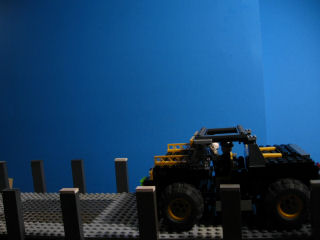

If you don't light your bluescreen well, you'll either have to throw out the shot and refilm it, or resort to handmasking, which is no fun. Notice this third example, where the bluescreen is dark on the corners but is the same color around the building and minifig:
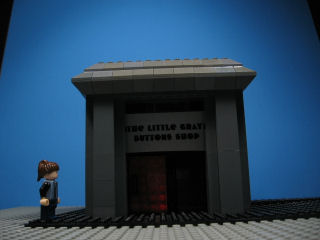
A bluescreen such as this is easier to remove than the first picture because only the edges are dark. In the final version of the shot, you can't even tell there was a bluescreen:
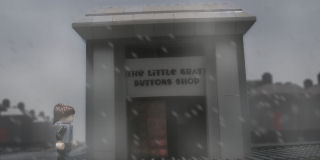
Another dead giveaway that a shot was filmed on bluescreen is if the foreground doesn't match the background. This usually has to do with the coloring or lightning. Later in this section I've discussed how to grade your effects.
Tips for using particles
Particles can be especially tricky because you'll run into seemingly unsolvable problems. For example, you might have a dark stormy night with lots of rain coming down. So, what happens to the rain when it hits the ground? In every Brickfilm I've seen that has rain, the rain doesn't hit the ground. It simply disappears. What I would do in this situation is have a spray bottle handy when animating, and lightly spray the set after each frame. Once you add the rain particles in later, it appears that the rain is hitting the ground! Keeping details such as this in mind will help your effects look more realistic. When using particles, keep in mind that movement is crucial in getting them to look believable. Most particle programs come with motion presets, but these are not always perfect. If you experiment for long enough, you'll start to get a good idea of what looks realistic and what doesn't.
Tips for 3D
3D CGI is undoubtedly the most complicated and difficult part of visual effects. Lighting and texturing are the two most important things to get right, and they're hard to get right. After importing models into Carrara, I always retexture them. This alone doubles how real they look – that, combined with clever cinematography and realistic lighting, can produce photorealistic CG images. This does not mean that you can suddenly do anything you want with CG – I wish that were the case. You are still severely limited in what will look realistic or not. Remember, you will never be able to do anything you want. Another way of getting your stuff to look more realistic is to not show long shots, a piece of advice I keep telling myself but have yet to follow. The longer the shot, the more time the viewer has to study what they're seeing, and the more chance they'll figure out it's digital. Finally, if you make an object such as a spaceship digital in every shot it's seen in, by the end of the film you can pretty much guarantee everyone will know it's not real. However, if you make it digital in some shots and real in others, and your CGI is pretty good, chances are the viewer will end up guessing which shots are which, or he might not even be able to tell at all. If you're trying to figure out whether or not your CGI looks real, then study real objects. If you're working with digital LEGO models, look at those then look at your real ones. How are they different? Why are they different? Most often the difference has to do with either lightning or texturing.
Tips for masking
I don't know who thought up masking, but they were a genius. Masking is a relatively easy way to make objects appear to float or fly. It is usually done in an image editing program, although After Effects and Blue Screen of Life can both do it to some extent. When filming your shot, be sure to take a background picture at the beginning and the end. If you take one just at the end, it won't match with the first frames of the shot; the same goes if you take a background picture just at the beginning. The most common error I see in masking is when the shadow is erased. In the following example there are two pictures, the original and the final versions. See how I kept the shadow of the hoverboard and the minifigure?
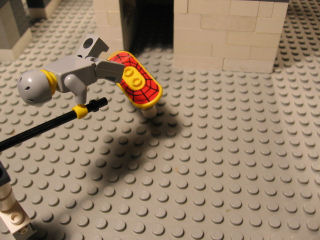
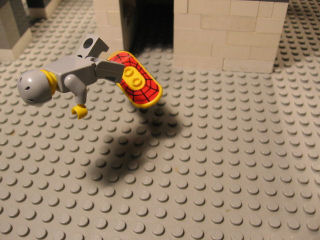
In general, expect to spend a lot of time on masking. I have spent 20 minutes on a single frame before, and it could be even worse. Fortunately, masking is one of the easiest effects to look believable. Zero Gravity Rebellion is a great Brickfilm everyone should see. It features an entire scene of a boy on a hoverboard, and the effect looks completely realistic.
Tips for other effects
Most other effects that I haven't covered above can be done in After Effects. Lightsabers Star Wars-like opening crawls, blasters, lights, lightning, and cool end credit sequences are some of these effects. If you're looking to do lots of Star Wars effects, www.theforce.net has a bunch of great tutorials. www.CreativeCOW.net also has endless After Effects tutorials that I have found quite useful.
Grading your effects
It is a fact that digital effects look perfectly pristine and clean. Your CG models will look smooth and shiny (texturing can help fix this), your lightsabers and everything else will look just perfect. There are two types of digital grading you can do to help "age" your effects. First, there is adding noise or grain to your effects so they don't look perfect, and then there is adjusting the coloring and lightning of your effects so they match your real footage, or visa versa. If you have a high quality MiniDV camera or a nice digital camera, you won't need to add much noise or grain to your effects, but if you have a webcam or cheaper camera, your effects will look out of place unless graded. After Effects is the best program I know of for doing this.
Brickfilms you should watch
Here is a list of Brickfilms everyone interested in visual effects should watch (and if you're like me, analyze):
Triumph of the Empire
Rise of the Empire
Zero Gravity Rebellion
True Love Waits
The Tompa City Menace
Capastroid
Faithless
Attack of the Drones
Robota
Frankenstein
Unrenewable
The goal with visual effects
You probably already know that the ultimate goal for anyone doing visual effects is to have their effects blend perfectly into the film and not be noticed. When asked about the effects, viewers should say: "Effects? What effects?" Getting there is very hard. It requires a lot of work, time, and in some cases, money. If you have gotten there, then you've done exactly what you set out to do. I hope this article has helped you a lot, and if you have any further questions, please Email or PM me (my Email is nickdurron@gmail.com).